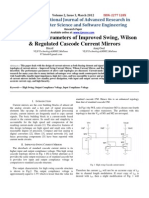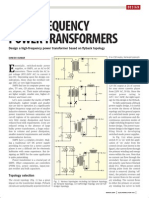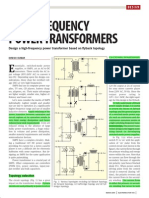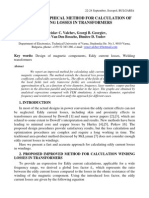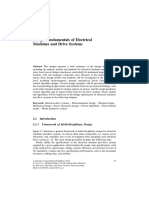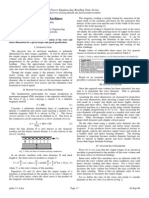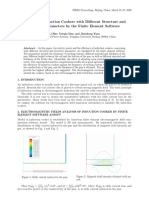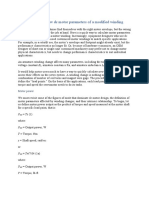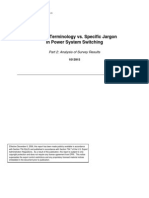Power Loss Calculation of High Frequency Transformers: Geun-Soo Choi, Shin-Yong Yoon, Soo-Hyun Baek and Kim Yong
Power Loss Calculation of High Frequency Transformers: Geun-Soo Choi, Shin-Yong Yoon, Soo-Hyun Baek and Kim Yong
Uploaded by
Dante FilhoCopyright:
Available Formats
Power Loss Calculation of High Frequency Transformers: Geun-Soo Choi, Shin-Yong Yoon, Soo-Hyun Baek and Kim Yong
Power Loss Calculation of High Frequency Transformers: Geun-Soo Choi, Shin-Yong Yoon, Soo-Hyun Baek and Kim Yong
Uploaded by
Dante FilhoOriginal Title
Copyright
Available Formats
Share this document
Did you find this document useful?
Is this content inappropriate?
Copyright:
Available Formats
Power Loss Calculation of High Frequency Transformers: Geun-Soo Choi, Shin-Yong Yoon, Soo-Hyun Baek and Kim Yong
Power Loss Calculation of High Frequency Transformers: Geun-Soo Choi, Shin-Yong Yoon, Soo-Hyun Baek and Kim Yong
Uploaded by
Dante FilhoCopyright:
Available Formats
338
Journal of Electrical Engineering & Technology, Vol. 1, No. 3, pp. 338~342, 2006
Power Loss Calculation of High Frequency Transformers
Geun-Soo Choi*, Shin-Yong Yoon*, Soo-Hyun Baek** and Kim Yong** Abstract This paper analyzed the power loss of transformers considering the magnetic component.
For this, each winding strategy and the effect of air gap between the ferrite core have been an important variable for optimal parameter calculation. Inductors are very well known design rules to devise, but the performance of the flyback converter as a function of transformer winding strategy has not been fully developed. The transformer analysis tool used was PExpert. The influence of the insulator thickness, effect of the air gap, how the window height and variation of the capacitive value effects the coil and insulator materials are some of parameters that have been analyzed in this work. The parameter analysis is calculated to a high frequency of 48[kHz]. Therefore, the final goal of this paper was to calculate and adjust the parameters according to the method of winding array and air gap minimizing the power loss.
Keywords: Flyback, High Frequency Transformer, PExpert, Power loss, Winding strategy
1. Introduction
SMPS (switch mode power supply) is used in the application of industrial control systems, namely OA, FA, robotics, Information machines, and LCD backlights. How it is designed is very important, particularly in the case of transformer design considering power loss at magnetic components. The transformer in this case is the flyback transformer that is able to store energy using a turn off switch. The purpose of this is to transfer power efficiently and instantaneously from an external electrical source to an external load [1-3]. Magnetic components are one of the important components in power electric circuits. The design stage of these components should be carried out not only taking into account the electrical specification of the circuit, but also the influence of the geometrical parameters as well as the material properties of all the parts that form the magnetic components. The usual procedure to design magnetic components allows us to obtain some of their parameters. However there are other very important parameters that are not included in that procedure due to the difficulty to quantify their influence on the magnetic components. The design method proposed in this paper is based on the use of a model that accounts for geometry and frequency effects using the FEA tool. The performance of the final component can be clearly improved by using the right winding strategy and materials for a given electrical
Dept. of Electrical Eng. Cop, DGI, 517 Deok-dong, Yangju-si, Kyunggi-do Korea. Phone : 82-31-860-1200 Fax : 82-31-865-0068 ( research@dgi-net.com ) ** Professor, Dept. of Elec. Eng, Dongguk University, Phil-dong 3, Joong-gu, Seoul, Korea Received: May 17, 2005 ; Accepted: January 27, 2006 *
specification [4-6]. This paper analyzes the effect of winding strategy and air-gap variation of the flyback transformer. Therefore, from those power losses, parameters for resistance, leakage inductance and temperature can be acquired.
2. Flybak Transformer
Fig. 1 indicates the flyback transformer converter driving the CCFL (Cold Cathode Fluorescent Lamp) by amplification of the piezoelectric transformer.
Fig. 1. Inverter of flyback transformer for CCFL Fig. 2 shows the dimension of the flyback transformer for Fig. 1. Here, this construction is applied to the core transformer of EI 28 type of the TDK corp.
(a) EI28 type (b) Dimension values Fig. 2. Transformer construction and dimension
Geun-Soo Choi, Shin-Yong Yoon, Soo-Hyun Baek and Kim Yong
339
2.1 Power Loss
Transformer losses can be put into three major categories: core hysteresis losses, core eddy current losses, and winding losses. Transformer loss is sometimes limited directly by the need to achieve the required overall power supply efficiency. More often, transformer losses are limited by a maximum hot spot temperature rise at the core surface within the center of the windings. The winding loss worst case is always at low Vin, full load. The analysis procedure is based on the use of the Maxwell Equation, shown below as (1) and (2).
eddy current loss is proportional to Vin. Worst case is at high voltage Vin. Winding loss is always greatest at low Vin. Fig. 3 is for self-capacitance and mutual capacitance of equivalency with analysis models.
(1)
Fig. 3. Self-capacitance and mutual capacitance of EI28 models
(2) Here, J = E , B = H DC resistance and AC resistance are represented as the following Equations (3) and (4).
RDC = l A
3. Simulation Result
(3)
RAC = RDC 1.6
(4)
DC resistance is constant to frequency, and AC resistance is high variable to frequency. The power losses of the winding are shown as follows in Eqs. (5), (6), (7).
(a)
(b)
P1 w = I 12DC R1 DC + I 12AC R1 AC
P2 w = I 22DC R 2 DC + I 22 AC R 2 AC
Pw = P1 w + P2 w
(5) (6) (7) (c) (d)
The power loss of the core is indicated as follows in Eq. (8).
PC = K 1 f
K 2
BK3
(8)
Here, PC : core loss, Pls : power loss, K1 : 0.32,
K 2 : 1.61, K 3 : 2.68.
Total power losses are shown as follows in Eq. (9).
Pls = PC + Pw
(9)
Fixed frequency operation, volts-seconds and therefore flux swing are constant. Hysteresis loss is therefore constant, regardless of changes in Vin or load current. Core
(e) (f) Fig. 4. Winding strategy of EI type core
340
Power Loss Calculation of High Frequency Transformers
Fig. 4 shows the represented analysis result of the EI28 type transformer by FEA Export. Here, constructions of analysis objects are the same as the following conditions: core size EI28, bobbin EI28, core material PC40, manufacture corp. TDK, window width 5,90[mm], window height 12,25[mm], volume 4145.20[mm]. The common condition for analysis of Fig. 4, circuit simulation conditions of the flyback transformer are as follows: duty cycle 0.5%, switching frequency 48kHz, operation condition: continuous mode, magnetizing inductance: 130.23[ H], Vin : 5[V], Irms : 1.417[A], permeability : 0.23[T], at Fig.3(a) winding1 structure: AWG 25, gap: 0.1637[mm], number of turns 15, parallel Turns 3. Fig. 4(b) winding1 structure: AWG 20, gap: 0.1931[mm], number of turns 16, parallel turns 1. Fig. 4(c) winding1 structure: AWG 25, gap: 0.1637[mm], number of turns 15, parallel turns 1. Fig. 4(d) winding1 structure: AWG 30, gap: 0.6151[mm], number of turns 25, parallel Turns 3. Fig. 4(e) winding1 structure: AWG 35, gap: 2.6416[mm], number of turns 42, parallel Turns 3. Fig. 4(f) winding1 structure: AWG 35, gap: 2.6416[mm], number of turns 42, parallel Turns 3. Here yellow rounding coils signify 1 order winding, blue rounding coils signify 2 order winding. Table 1 reveals the AC resistances, DC resistances, and capacitance analysis by PExprt. Table 1. AC/DC Resistance and Capacitance
Items AC Res. Wind.1 [m] Wind.2 [] Wind.1 [m] Wind.2 [m] Self Cap [pF] Mutual. Cap. [pF]
1 35.5 3.8 35.6 35.6 6.86 31.7 2 37.8 7.07 36.1 36.1 4.61 25.8 3 98.8 11.5 98 98 6.8 31.7 4 184.5 19.17 184 184 10.55 48.8 5 966.3 31.52 966.3 966.3 10.55 48.96 6 966.3 10.04 966.3 966.3 10.55 48.96
4 Pow er loss[w ] 3.5 3 2.5 2 1.5 1 0.5 0
Winding type
Fig. 6. Power loss to winding types Fig. 5 shows winding loss, core loss, and total loss for the winding constructor of Fig. 4. Here number 6 is largest at total loss, because the gap and turns are big, and the diameter is small. Number 1 is lowest at total loss, because gap and turns are small, and diameter is large. Fig. 6 represents the power loss of total loss at Fig. 4. It is equal to the explanation of Fig. 5.
3 2. 5 Gap[mm] 2 1. 5 1 0. 5 0 1 2 3 4 5 6 W indings ty pe
DC Res.
Fig. 7. Gap values to winding types
100 90 80 Temperature[^c
Cap.
4.5 4 3.5 3 2.5 2 1.5 1 0.5 0
Total loss Core Windings
70 60 50 40 30 20 10
3 4 Windings type
0 1 2 3 4 5 6 Windings type
Fig. 5. Winding loss, core loss, and total loss for winding constructors
Fig. 8. Temperature for winding arrays
Geun-Soo Choi, Shin-Yong Yoon, Soo-Hyun Baek and Kim Yong
341
Fig. 7 shows the gap value for winding type. The explanation for this is represented in Fig. 4. Fig. 7 depicts temperature loss, with number 6 indicating the biggest temperature rise. Fig. 9 indicates DC loss and resistance for winding type. Here Numbers 1 and 2 represent the least amount of loss.
2500 2000 Resistance, Loss 1500 1000 500 0 1 2 3 4 5 6 Windings type
Fig. 12 represents the flux density distribution of the above analysis model (EI28) by Maxwell-2D.
DC Losses[m W] DC Res.[m ohm ]
Fig. 9. DC loss and resistance for winding types Fig. 12. Flux density distribution of EI28 type core Fig. 10 represents AC resistance at 1 and number 2 shows winding. Number 6 indicates the largest ac resistance.
Winding 1 120 100 AC Resistance 80 60 40 20 0 1 2 3 4 5 6 Windings type Winding 2
3. Conclusions
Transformer design at the SMPS is very important to considering loss. For this, it is required to obtain the parameters for loss considering winding strategy. This paper analyzed power loss according to the winding strategy of the flyback transformer. Here, the simulation tool used was PExprt. From the above analysis result considering parameters, namely winding diameter, gap, turns, resistance, temperature, leakage inductance etc., the EI28 type of number 1 shows the smallest power loss.
Fig. 10. AC resistance of 1, 2 winding Fig. 11 illustrates leakage inductance to winding type. Here number 3 indicates lowest leakage inductance, while numbers 5 and 6 represent the biggest leakage inductance.
2 1.8 1.6 1.4 1.2 1 0.8 0.6 0.4 0.2 0 1 2 3 4 5 6 Winding types
References
[1] J. P. Vandelac and P. Zioggas, A Novel Approach for Minimizing High Frequency Transformer Copper Losses, Journal of IEEE, pp. 355-367, 1987. [2] R. Petkov, Design Issues of the High Power High Frequency Transformer, IEEE PCIM, pp. 401-410, 1995. [3] R. Prieto, J. A. Cobos, O. Garcia and J. Uceda, Study of the Sensitivity of the Parameters in Magnetic Components, PESC, pp. 355-360, 1997. [4] R. Prieto, J. A. Cobos, O. Garcia and J. Uceda, 1D Magnetic Component Model for Planar Structures, PESC, pp. 574-579, 1999. [5] R. Prieto, J. A. Cobos, O. Garcia and J. Uceda, Using
Leakage inductance[uH
Fig. 11. Leakage inductance to winding types
342
Power Loss Calculation of High Frequency Transformers
Parallel Winding in Planar Magnetic Components, PESC , pp. 2055-2060, 2001. [6] L.M. Escribano, R.Prieto, J.A. Oliver, J.A. Cobos and J. Uceda, New modeling strategy for the fringing energy in magnetic components with air gap, PESC, pp. 144-150, 2002.
Geun-Soo Choi He received his B.S. degree in Electrical Engineering from Wonkwang University in 1983. He received his M.S. degree from Dongguk University, Seoul, Korea in 1995. He has been studying to obtain his Ph.D at Dongguk University since 2002. His main area of interest includes Inkjet printing systems, Digital Textile Printing, Servo motor control, FPCB control systems and Cutting Plotters.
Soo-Hyun Baek He received his B.S., M.S. and Ph.D. degrees in Electrical Engineering from Hanyang University in 1972, 1974 and 1983, respectively. Since 1977, he has been a Professor in the Department of Electrical Engineering at Dongguk University, Seoul, Korea. He has also been a member of the KIEE and ICEE. His major research interests are in the areas of motor control systems, power electronics, ultrasonic motors and the design and analysis of electrical machines.
Shin-Yong Yoon He received his B.S. degree in Electrical Engineering from Seoul National University of Technology in 1992. He received his M.S. and Ph.D degrees in Electrical Engineering from Dongguk University, Seoul, Korea in 1994 and 1999, respectively. His main research interest includes Inkjet printing, Servo motor control, and Linear motor design.
Kim Yong He received his B.S., M.S. and Ph.D. degrees in Electrical Engineering from Dongguk University in 1981, 1984 and 1994, respectively. Since 1977, he has been a Professor in the Department of Electrical Engineering at Dongguk University, Seoul, Korea. His major research interests are in the areas of motor control systems, SMPS and Grounding systems.
You might also like
- Baliga Figure of MeritDocument3 pagesBaliga Figure of MeritKyle BotheNo ratings yet
- Comparacion Center Tap Vs DoublerDocument4 pagesComparacion Center Tap Vs DoublerGustavo MarquezNo ratings yet
- Gate Drive TrafoDocument4 pagesGate Drive Trafobenygiurgiu100% (1)
- Thermal Design of 25ka Current Injection Transformer (CIT) With Finite Element MethodDocument6 pagesThermal Design of 25ka Current Injection Transformer (CIT) With Finite Element MethodConstantin DorinelNo ratings yet
- Design and Analysis of 42-V Permanent-Magnet Generator For Automotive ApplicationsDocument12 pagesDesign and Analysis of 42-V Permanent-Magnet Generator For Automotive ApplicationsNicholas ValdezNo ratings yet
- Design and Implementation of A 300A Modular Welding Inverter (#548547) - 748210Document9 pagesDesign and Implementation of A 300A Modular Welding Inverter (#548547) - 748210avsargokserNo ratings yet
- Models - Acdc.ecore TransformerDocument32 pagesModels - Acdc.ecore TransformerAdrian GarciaNo ratings yet
- Design Methodology of A Permanent MagnetDocument10 pagesDesign Methodology of A Permanent MagnetJian ZhangNo ratings yet
- Stray Loss Evaluation in Power TransformersDocument6 pagesStray Loss Evaluation in Power Transformersbtd2011No ratings yet
- E-Core Transformer: Created in COMSOL Multiphysics 5.4Document32 pagesE-Core Transformer: Created in COMSOL Multiphysics 5.4José Angel RamirezNo ratings yet
- Models - Acdc.ecore TransformerDocument34 pagesModels - Acdc.ecore TransformerAnonymous sAmJfcVNo ratings yet
- V2I300142Document3 pagesV2I300142editor_ijarcsseNo ratings yet
- Power Transformer DesignDocument4 pagesPower Transformer DesignMetalloyNo ratings yet
- E Core Transformer Modelling Using Comsol MultiphysicsDocument34 pagesE Core Transformer Modelling Using Comsol MultiphysicsDinesh PerumalsamyNo ratings yet
- 15Document11 pages15dr_best_001No ratings yet
- 12 Steps For Designing SMPS TransformersDocument11 pages12 Steps For Designing SMPS TransformersRnDES1 CMLNo ratings yet
- Transformer DesigneDocument6 pagesTransformer Designemhm770077100% (1)
- Transformer Modeling in Atp EmtpDocument6 pagesTransformer Modeling in Atp Emtpmspd2003No ratings yet
- 5.ohmic FullDocument10 pages5.ohmic FullTJPRC PublicationsNo ratings yet
- Question Bank EMDDocument23 pagesQuestion Bank EMDd_rajmtechNo ratings yet
- Modeling of Electric Motors For Electromagnetic Compatibility AnalysisDocument5 pagesModeling of Electric Motors For Electromagnetic Compatibility AnalysisRudanekNo ratings yet
- Äñ Æ÷Éè Æ Ó ©Document6 pagesÄñ Æ÷Éè Æ Ó ©Rachel RowlandNo ratings yet
- High Frequency Power Transformers - Design A High-Frequency Power Transformer Based On Flyback TopologyDocument6 pagesHigh Frequency Power Transformers - Design A High-Frequency Power Transformer Based On Flyback TopologyShyam Bin Jamil100% (1)
- Question Bank For Emd-1Document5 pagesQuestion Bank For Emd-1the_ray004No ratings yet
- A Pulse TransformerDocument12 pagesA Pulse TransformerPooja Uchagaonkar100% (2)
- Colicraft Power Transformer DesignDocument4 pagesColicraft Power Transformer DesignPablo KuziwNo ratings yet
- Improved Graphical Method For Calculation of Winding Losses in TransformersDocument6 pagesImproved Graphical Method For Calculation of Winding Losses in Transformerstapioca57No ratings yet
- Gujarat Technological UniversityDocument2 pagesGujarat Technological UniversityPalak AriwalaNo ratings yet
- Models - Mems.pyroelectric DetectorDocument20 pagesModels - Mems.pyroelectric Detectormaxim.jouvalNo ratings yet
- Detection of Winding Deformation in Power Transformer: Seminar Presentation OnDocument18 pagesDetection of Winding Deformation in Power Transformer: Seminar Presentation Ongokul_iyer2001100% (1)
- Analysis of Axial Flux MotorDocument4 pagesAnalysis of Axial Flux MotorAvi GuptaNo ratings yet
- 10 - Overvoltage Calculation by Monte Carlo Method With Accurate Substation Components Modeling PDFDocument5 pages10 - Overvoltage Calculation by Monte Carlo Method With Accurate Substation Components Modeling PDFAnonymous IjLgxu9fXPNo ratings yet
- 3-Phase PFC KolarDocument7 pages3-Phase PFC KolarJayant SalianNo ratings yet
- Question Bank of DDMTDocument4 pagesQuestion Bank of DDMTpeqpereNo ratings yet
- Minor ProjetDocument10 pagesMinor Projetsanhiksarkar.9.a.11.2020No ratings yet
- Optimal Design of A High Power High Frequency TransformerDocument10 pagesOptimal Design of A High Power High Frequency TransformerPablo KuziwNo ratings yet
- Two-Level and Three-Level Converter Comparison in Wind Power ApplicationDocument11 pagesTwo-Level and Three-Level Converter Comparison in Wind Power ApplicationIkram RidhoNo ratings yet
- Design Calculation and Performance Testing of Heating Coil in Induction Surface Hardening Machine PDFDocument5 pagesDesign Calculation and Performance Testing of Heating Coil in Induction Surface Hardening Machine PDFMohammedNo ratings yet
- Design Fundamentals of Electrical Machines and Drive SystemsDocument11 pagesDesign Fundamentals of Electrical Machines and Drive Systemsgurunathan14No ratings yet
- Pebn009 Sizing of Electrical Machines PDFDocument2 pagesPebn009 Sizing of Electrical Machines PDFvishiwizardNo ratings yet
- Wat MetersDocument13 pagesWat MetersKornepati SureshNo ratings yet
- 15.1 Transformer Design: Basic ConstraintsDocument22 pages15.1 Transformer Design: Basic Constraintsniku_No ratings yet
- Ems FNLXM A99 ADocument13 pagesEms FNLXM A99 AdalbaasNo ratings yet
- Simulation of Induction Cookers With Different Structure and Material Parameters by The Finite Element SoftwareDocument5 pagesSimulation of Induction Cookers With Different Structure and Material Parameters by The Finite Element SoftwareVaibhav GanatraNo ratings yet
- Emd-I AssignmentDocument6 pagesEmd-I Assignmentayan PatelNo ratings yet
- Stray Loss Evaluations in Power Transformers PDFDocument6 pagesStray Loss Evaluations in Power Transformers PDFsulemankhalidNo ratings yet
- How To Calculate New DC Motor Parameters of A Modified WindingDocument7 pagesHow To Calculate New DC Motor Parameters of A Modified WindingIqbal BaigNo ratings yet
- Design Fundamentals of Electrical Machines and Drive SystemsDocument49 pagesDesign Fundamentals of Electrical Machines and Drive SystemsJavier MejiaNo ratings yet
- Models - Acdc.ecore TransformerDocument34 pagesModels - Acdc.ecore TransformerAnonymous gB76eOdR100% (1)
- Chap15 PDFDocument22 pagesChap15 PDFlighthouse2510No ratings yet
- A Study On Overvoltages in Wind Tower Due To Direct Lightning StrokeDocument6 pagesA Study On Overvoltages in Wind Tower Due To Direct Lightning Strokebal3xNo ratings yet
- Design Analysis and Simulation of Magnetic Biased Inductors With Saturation-Gap - EPE2014Document8 pagesDesign Analysis and Simulation of Magnetic Biased Inductors With Saturation-Gap - EPE2014andresNo ratings yet
- Coated Electrode Manual-Metal Arc Welding With High Frequency Welding Inverter Power SourcesDocument6 pagesCoated Electrode Manual-Metal Arc Welding With High Frequency Welding Inverter Power Sourcessapreswapnil8388No ratings yet
- Minor ProjectDocument9 pagesMinor Projectsanhiksarkar.9.a.11.2020No ratings yet
- Resistivity Modeling: Propagation, Laterolog and Micro-Pad AnalysisFrom EverandResistivity Modeling: Propagation, Laterolog and Micro-Pad AnalysisNo ratings yet
- Physics and Technology of Crystalline Oxide Semiconductor CAAC-IGZO: Application to DisplaysFrom EverandPhysics and Technology of Crystalline Oxide Semiconductor CAAC-IGZO: Application to DisplaysNo ratings yet
- Electricity in Fish Research and Management: Theory and PracticeFrom EverandElectricity in Fish Research and Management: Theory and PracticeNo ratings yet
- Organic Light-Emitting Transistors: Towards the Next Generation Display TechnologyFrom EverandOrganic Light-Emitting Transistors: Towards the Next Generation Display TechnologyNo ratings yet
- 1 Glaubitz HighVoltageGIS PDFDocument28 pages1 Glaubitz HighVoltageGIS PDFDante FilhoNo ratings yet
- 2 - Transformer Inrush Current PDFDocument5 pages2 - Transformer Inrush Current PDFvksharma13No ratings yet
- 02 - Mohammed Al RamadhanDocument0 pages02 - Mohammed Al RamadhanDante FilhoNo ratings yet
- 00+colloquium ProgrammeID45VER27Document8 pages00+colloquium ProgrammeID45VER27Dante FilhoNo ratings yet
- 000000000001010627Document302 pages000000000001010627Dante Filho100% (2)
- 000000000001025844Document54 pages000000000001025844Dante FilhoNo ratings yet
- IJEEE - Comparisen of - Om Prakash MahelaDocument10 pagesIJEEE - Comparisen of - Om Prakash Mahelaiaset123No ratings yet
- 00 Converter and Transformation Stations Site Blato in Lastva GrbaljskaDocument28 pages00 Converter and Transformation Stations Site Blato in Lastva GrbaljskaDante FilhoNo ratings yet
- Survey of Fault Current Limiter (FCL) TechnologiesDocument72 pagesSurvey of Fault Current Limiter (FCL) TechnologiesDante FilhoNo ratings yet
- Generic Terminology vs. Specific Jargon in Power System SwitchingDocument106 pagesGeneric Terminology vs. Specific Jargon in Power System SwitchingDante FilhoNo ratings yet
- 230 KV Accelerated Aging Chamber: 2006: Condition of Composite Components After One Year of OperationDocument130 pages230 KV Accelerated Aging Chamber: 2006: Condition of Composite Components After One Year of OperationDante FilhoNo ratings yet
- 00+colloquium ProgrammeID45VER27Document8 pages00+colloquium ProgrammeID45VER27Dante FilhoNo ratings yet
- Determination of The Insulation Classification of Some Nigerian Paper ProductsDocument4 pagesDetermination of The Insulation Classification of Some Nigerian Paper ProductsDante FilhoNo ratings yet
- 000000000001019531Document320 pages000000000001019531Dante FilhoNo ratings yet
- On-Line Vibration Technology Development: Feasibility of Commercialization of TechnologyDocument50 pagesOn-Line Vibration Technology Development: Feasibility of Commercialization of TechnologyDante Filho100% (1)
- Sulfur Hexafluoride Leak Detection Techniques: New SF Camera Development and TestingDocument50 pagesSulfur Hexafluoride Leak Detection Techniques: New SF Camera Development and TestingDante FilhoNo ratings yet
- 1.12 GL For Modernization and Renovation of SHP StationsDocument50 pages1.12 GL For Modernization and Renovation of SHP StationsDante FilhoNo ratings yet
- Electrical Condition Assessment of Polymer Insulators For Live WorkingDocument40 pagesElectrical Condition Assessment of Polymer Insulators For Live WorkingDante FilhoNo ratings yet
- Promising Technologies For The Inspection of Polymer Insulators: Technology Review and EvaluationDocument50 pagesPromising Technologies For The Inspection of Polymer Insulators: Technology Review and EvaluationDante FilhoNo ratings yet












